Free flowing, transparent gamma alumina nanoparticles synthesized by a supersonic thermal plasma expansion process
Texto completo
Figure



Documento similar
Conceptual model of the system: (a) Thermal sensor connected to the Khepri; (b) Data package generated by the system; (c) Thermal information and georeferentiation of the system
(d) Comparison between the SPA prediction (red curves) for the supercon- ducting energy gap and those obtained by using Dynes expression to fit the dI /dV obtained by the SPA
In addition, the size distribution of carbon coated iron nanoparticles is broad by using this method as shown in TEM image (a) and size distribution histogram (b) of Figure
For samples grown at high enough substrate temperature under Cu-excess conditions, the co-evaporation process leads to the formation of a chalcopyrite phase with good
All spectral states consistent with pure non-thermal acceleration models, Hard state compatible with pure synchrotron Comptonization. Spectral transitions: thermal disc photons
Mazarío, “Effect of the surface charge on the adsorption capacity of chromium (VI) of iron oxide magnetic nanoparticles prepared by microwave-assisted synthesis,”.
In the first stage electrons from Ga moves through vacancies of the oxide until they reach the oxide-air interface and ionize oxygen atoms (red circles). These ions diffuse
So the flux of reflected plasma particles in the case of oxygen plasma is expected to deposit more energy onto the substrate than in the case of argon plasma, thus promoting